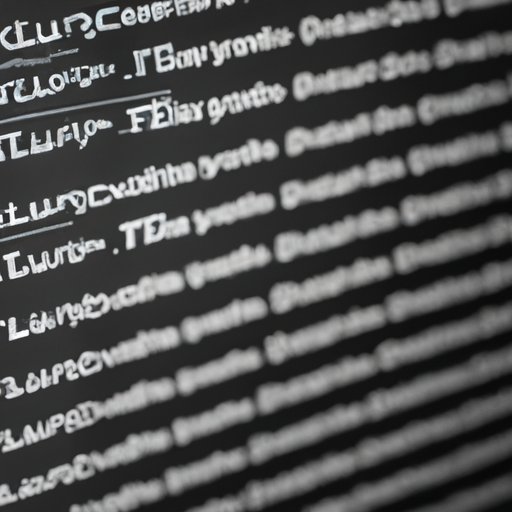
I. Introduction
Flipping the screen on your computer may seem like a silly trick, but it can actually be quite useful. Whether you want to change the orientation for better readability, or you need to flip the screen after accidentally hitting a keyboard combination, knowing how to flip the screen is a handy trick to have up your sleeve. In this article, we’ll show you how to flip the screen on your Windows or Mac computer in an easy step-by-step guide. We’ll also offer troubleshooting tips, recommended software/apps, and explore the benefits of flipping your screen beyond just problem-solving.
II. Step-by-Step Guide
Flipping the screen on your Windows or Mac computer is a simple process, but the exact steps you need to take depend on the operating system you’re using. Below, we’ve broken down the process for both Windows and Mac users.
Windows
- Press the Ctrl + Alt + arrow key (left, right, up or down) to flip the screen orientation.
- If the orientation doesn’t change, right-click on the desktop and select “Display settings.”
- Scroll down to “Orientation” under “Scale and layout.”
- Select the desired orientation from the drop-down menu.
If you’re using Windows 7 or an older version, the process may be slightly different. Go to the Control Panel, select “Appearance and Personalization,” then “Display,” and finally “Screen Resolution.” From there, you can change the orientation using the drop-down menu.
Mac
- Press the Command + Option + arrow key (left, right, up or down) to flip the screen orientation.
- If the orientation doesn’t change, go to the Apple menu, select “System Preferences,” and then “Displays.”
- Select the “Rotation” drop-down menu and choose the desired orientation.
If you’re using an older version of MacOS, the process may be slightly different. Look for the “Displays” settings in the System Preferences menu and follow the same steps above.
While flipping the screen on your computer is generally a straightforward process, it’s important to note that some graphics cards or drivers may not support certain orientations. If you encounter issues or error messages, try troubleshooting using the tips below.
III. Troubleshooting Tips
If your computer’s screen failed to flip using the methods above, here are some troubleshooting tips you can try:
- Restart your computer: Sometimes all it takes is a quick restart to fix the issue.
- Update your graphics driver: Check the website of your computer manufacturer and download the latest graphics drivers for your specific device.
- Check your graphics card compatibility: In some cases, certain graphics cards may not support certain screen orientations. If you’re trying to use a non-standard orientation, try switching to a supported one.
- Try a different keyboard combination: Depending on your computer and operating system, the keyboard combination to flip the screen may vary. Experiment with different key combinations and try again.
IV. Best Software/Apps
If you’re looking for more advanced options for flipping your screen, there are several software/apps available that offer additional features and customization options. Here are some of the best options out there:
- Windows 10 and MacOS already have the flip screen option built-in, but if you’re still using an older version of Windows like Windows 7 or 8, you might want to look into third-party software.
- Flipping the screen is a standard feature on many graphics software like Photoshop and Adobe InDesign, which can be useful for graphic designers and digital artists.
- If you’re looking for a free option, iRotate is a popular software for flipping the screen that works with both Windows and Mac computers.
- If you want a more robust solution with advanced features and support, you may want to try DisplayFusion, which comes in both free and paid versions for Windows.
V. The Benefits of Flipping the Screen
Outside of the practical benefits of flipping the screen for better readability or accidental keyboard triggers, there are several other reasons why flipping the screen can be a useful trick to keep in your arsenal. One example of this could be for sharing your screen with someone else, making it easier for them to view the information you’re presenting. Another example could be if you’re working with a drawing model on your computer, flipping the screen could allow you to better manipulate the object at different angles.
VI. Video Tutorial
If you prefer a visual tutorial or want to supplement the guide above, check out our video tutorial below. We’ve broken down the process step-by-step with accompanying commentary and tips:
VII. Conclusion
Flipping the screen on your computer can come in handy more often than you might think. With the step-by-step guide and troubleshooting tips provided in this article, you should be able to successfully flip your screen regardless of your operating system. Remember, if you do encounter any issues, be sure to try out the troubleshooting tips we’ve provided for additional help. Flipping the screen may not be a groundbreaking feature, but it’s definitely a useful one to have in your toolkit.
Whether you’re a productivity enthusiast or just someone looking for a fun trick to impress your friends, we hope you found this article helpful.





